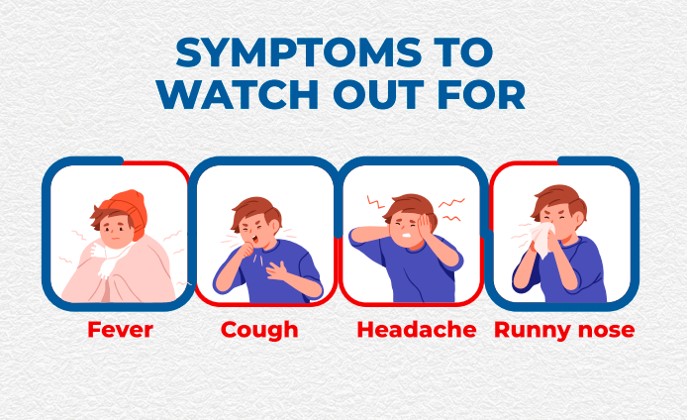
If you look around your office, your neighborhood or your family WhatsApp group, it seems like everyone is down with a nasty cough, high fever, and body aches. You’re not imagining it. A significant wave of seasonal influenza, driven predominantly by the H3N2 virus, is sweeping across Delhi-NCR, making it one of the worst flu seasons in recent years.
Hospitals and clinics are reporting a massive influx of patients, and pharmacies are seeing a run on medications. It’s more crucial than ever to be informed, not alarmed. Let’s break down what’s happening.
What Exactly is the H3N2 Virus?
H3N2 is a subtype of the Influenza A virus, one of the most common types of flu viruses that cause seasonal epidemics. It’s not a new virus; it has been circulating in humans since the 1968 pandemic. However, flu viruses are notorious for mutating and this year’s strain appears to be both highly transmissible and causing more severe symptoms in some individuals.
According to the World Health Organization (WHO), Influenza A(H3N2) viruses have been the dominant strain detected in many countries this flu season.
The Scale of the Outbreak: The Data Speaks
The numbers are startling. While official government figures are compiled with a time lag, data from health authorities and leading medical institutions paint a clear picture of a major outbreak:
- High Attack Rate: Recent reports, including data from the Indian Council of Medical Research (ICMR), suggest that the H3N2 virus has been causing a large number of hospitalizations. It is estimated that influenza-like illness (ILI) is affecting a significant portion of the population in several states, with Delhi-NCR being a hotspot.
- Dominant Strain: The ICMR’s network of viral research and diagnostic laboratories has confirmed that H3N2 is the dominant circulating strain, accounting for a majority of the flu cases detected in their surveillance.
- Vulnerable Groups Hit Hard: While the virus can affect anyone, public health advisories from the Union Ministry of Health and Family Welfare highlight that older adults, young children, pregnant women, and individuals with underlying chronic conditions (like asthma, diabetes, heart disease) are at a higher risk of severe complications, such as pneumonia.
H3N2 Symptoms: More Than Just a Common Cold
The symptoms of H3N2 are similar to other flu viruses but are often reported to be more intense and prolonged, especially the cough. Key symptoms include:
- High-grade fever that comes on suddenly
- A persistent and dry cough that can last for two to three weeks
- Severe sore throat
- Runny or stuffy nose
- Body aches, headache, and fatigue
- Some people may experience chills, nausea, or diarrhea (more common in children)
The prolonged cough is a hallmark of this particular wave, leaving many people unwell for an extended period.
How to Protect Yourself and Your Family

Prevention is always better than cure. The measures we perfected during the COVID-19 pandemic are highly effective against the flu as well.
- Get Vaccinated: The single most effective way to prevent the flu is to get an annual flu shot. The seasonal influenza vaccine is designed to protect against H3N2 and other circulating strains. It may not prevent infection entirely, but it significantly reduces the severity of the illness and the risk of hospitalization. Consult your doctor about getting vaccinated.
- Practice Good Hand Hygiene: Wash your hands frequently with soap and water or use an alcohol-based hand sanitizer.
- Wear a Mask: In crowded indoor spaces like metros, malls, or markets, wearing a well-fitted mask (like an N95 or KN95) can drastically reduce your risk of inhaling the virus.
- Avoid Touching Your Face: The virus can enter your body through your eyes, nose, and mouth.
- Maintain Distance: If someone is visibly sick, try to maintain a safe distance.
If You Get Sick: Do’s and Don’ts
- DO: Isolate yourself at home to avoid spreading the virus. Get plenty of rest and stay hydrated. Consult a doctor for symptomatic relief (medicines for fever and body aches).
- DON’T: Do not self-medicate with antibiotics. The flu is caused by a virus, and antibiotics are ineffective against viruses. Misuse of antibiotics can lead to resistance. Avoid taking leftover medicines from previous illnesses.
When to Seek Immediate Medical Attention
Contact a doctor immediately if you or a family member experience:
- Difficulty breathing or shortness of breath
- Persistent pain or pressure in the chest
- Confusion or dizziness
- Severe weakness or a fever that doesn’t subside with medication
The Bottom Line
The H3N2 outbreak is a serious public health concern, but it is manageable. By staying informed, taking preventive measures seriously, and following responsible practices if we fall ill, we can collectively curb the spread and protect the most vulnerable among us.
Stay safe, stay informed, and prioritize your health.
Sources & Further Reading:
- World Health Organization (WHO) – Influenza Updates
- Indian Council of Medical Research (ICMR) – Press Releases
- Ministry of Health and Family Welfare, Government of India – Public Advisories
